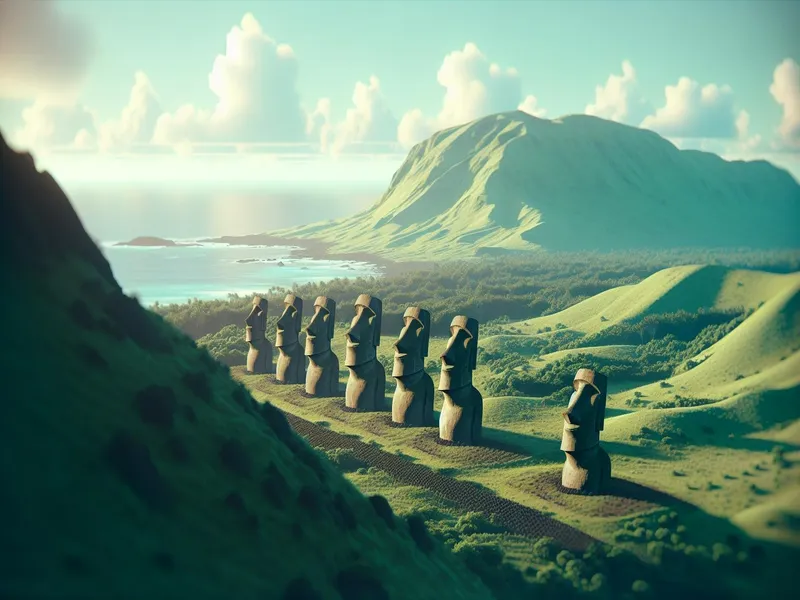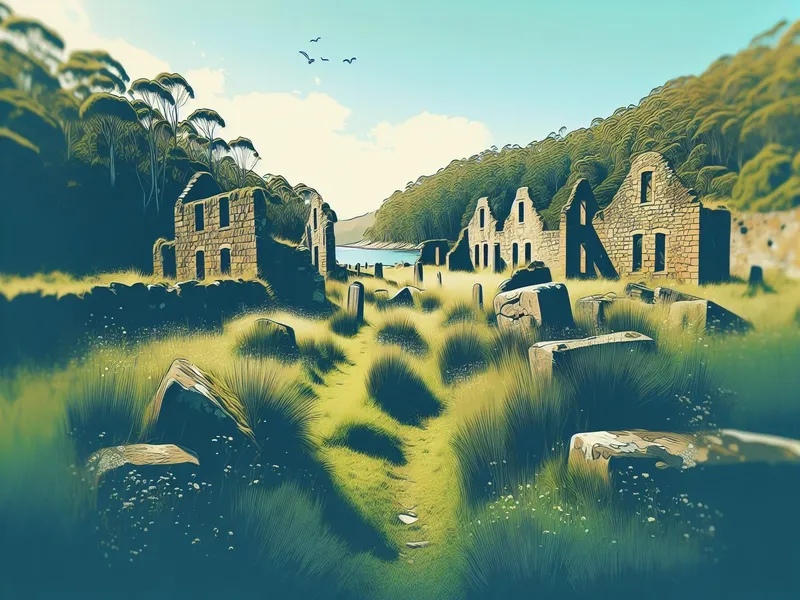
Whether you’re fascinated by ancient Polynesian cultures, colonial landmarks, or World War II sites, this region offers countless historical treasures waiting to be discovered. If you’re planning your next trip and want to dive deep into the past, you’ve come to the right place.
Ignoring the historical gems of Oceania means missing out on an essential part of its cultural fabric. Without understanding its past, you might find your travels less enriching and more superficial. The stories behind these places add depth and meaning to every visit, making each destination far more memorable.
Having traveled extensively through Oceania myself, I can confidently guide you through its most significant historical sites. My experience ensures you’ll get insider tips that typical guides might overlook. For more travel activities that complement your historical journey, check out our detailed articles here.
Discovering Ancient Cultures
Exploring Oceania isn’t just about the stunning beaches and crystal-clear waters. It’s also a deep jump into some of the world’s most fascinating ancient cultures.
Polynesian Voyages
Polynesian navigators were like the astronauts of their time, exploring vast oceanic distances without modern tools. Imagine setting out to sea with nothing but stars and waves as your guide! These expert sailors used techniques like “wave piloting,” reading the patterns of waves against islands. One standout site is Hawaiki, believed to be the mythical homeland of many Polynesian cultures. Visiting places like Rapa Nui (Easter Island), you’ll encounter those iconic moai statues, each with its own story.
Melanesian Heritage
Melanesia’s cultural richness is mind-blowing. Picture this: in Vanuatu, there’s a tradition called Land Diving – it’s like bungee jumping but way more intense and spiritual. They jump from tall wooden towers with vines tied to their ankles! This ritual isn’t just for kicks; it’s deeply connected to their beliefs about fertility and harvests. If you visit Fiji, don’t miss a traditional kava ceremony. Sharing this mildly narcotic drink made from kava roots connects visitors directly with local customs.
Micronesian Traditions
Micronesia might be small dots on the map, but it packs a punch in cultural heritage. Take Yap Island for example – they use gigantic stone money called Rai stones! Imagine using huge carved limestone discs for transactions; it’s wild yet deeply meaningful within their community structure. In Palau, you can explore ancient stone paths leading to impressive village remains that tell tales of warriors and chiefs long gone.
By diving into these rich histories, you’re not just seeing sights; you’re connecting with stories that stretch back thousands of years, making every step through Oceania more profound than any guidebook could capture.
Significant Historical Sites

Exploring Oceania’s historical sites feels like stepping into a time machine. You don’t just see the past; you experience it.
Easter Island’s Moai Statues
Ever wondered how on earth those giant stone heads got there? The moai statues of Easter Island, or Rapa Nui, are mind-blowing. These colossal figures, some towering over 30 feet tall and weighing up to 80 tons, were crafted by the Rapa Nui people using volcanic tuff (a soft rock). Picture this: you’re standing among these ancient giants with their solemn faces turned towards the island’s interior as if guarding its secrets. I remember feeling incredibly small yet connected to something immensely grand when I first saw them.
The Ruins of Nan Madol
Let me take you to Micronesia’s hidden gem—Nan Madol. This site is often dubbed the “Venice of the Pacific” because it’s a series of small artificial islands linked by canals. Imagine exploring through these watery pathways while exploring ancient ruins that date back to at least the 8th century AD! Built primarily from basalt columns, Nan Madol served as the ceremonial center for the Saudeleur dynasty. I once spent an entire afternoon wandering these ruins; each turn revealed a new mystery about this lost civilization.
New Zealand’s Waitangi Treaty Grounds
Next stop: Waitangi Treaty Grounds in New Zealand’s Bay of Islands. Here lies one of Oceania’s most pivotal historical sites where Maori chiefs and British Crown representatives signed the Treaty of Waitangi in 1840—a foundational moment for modern New Zealand. Walking through these grounds, you’ll find yourself immersed in history with exhibits detailing both perspectives on this treaty. When I visited, watching a traditional Maori performance added an extra layer to my understanding of their rich culture and heritage.
Experiencing these places firsthand gives travel a whole new meaning—one where every step you take uncovers stories that shaped entire cultures and histories.
Colonial Influence and Landmarks

Exploring the colonial influence in Oceania gives you a fascinating glimpse into how these islands were shaped by their interactions with European powers. From Australia’s convict history to Fiji’s colonial architecture, each landmark tells a unique story.
Australia’s Convict Sites
Australia’s convict sites are like stepping into a live-action history book. You can visit places like Port Arthur in Tasmania, which was one of the largest penal colonies. The eerie ruins here tell tales of harsh punishments and daring escapes. If you’re intrigued by prison life, the Hyde Park Barracks in Sydney offers an immersive experience with its interactive exhibits detailing the lives of convicts who built much of modern Australia.
Fiji’s Colonial Architecture
In Fiji, colonial architecture stands as beautiful yet poignant reminders of British rule. Walking through Suva, you’ll notice grand buildings like the Grand Pacific Hotel and Government House, both perfect for Instagram shots if that’s your thing! These structures blend Fijian motifs with Victorian elements, creating a unique architectural style that’s both elegant and historically rich.
French Polynesia’s Historical Forts
French Polynesia boasts historical forts that reflect military strategies from another era. On Tahiti, check out Fort Vai’ete, constructed to protect Papeete from naval attacks. Imagine standing on these ancient ramparts—it’s almost like you’re in an old war movie scene but with stunning ocean views! Over on Moorea Island, there’s Fort de Tepaia; though mostly ruins now, it’s still worth visiting for its historical significance and panoramic vistas.
Each site not only offers incredible photo opportunities but also deepens your understanding of how colonialism has left its mark on Oceania’s diverse cultures and landscapes.
Cultural Experiences and Tours
Exploring Oceania isn’t just about soaking in the sun. It’s also a journey through time, offering chances to jump into rich cultural experiences. Let’s talk about some unforgettable tours and events that bring history to life.
Guided Historical Tours
For a more immersive experience, guided historical tours are your best bet. Imagine walking through Port Arthur’s convict ruins in Tasmania while a guide recounts tales of escape attempts and daily hardships. Or picture yourself on Easter Island, standing beside a moai statue as an archaeologist explains its mysterious origins. These tours don’t just show you sites; they tell you stories that textbooks can’t capture.
Here’s why guided tours rock:
- Expert Insights: Learn from historians and locals
- Hidden Gems: Discover off-the-beaten-path spots
- Interactive Experience: Engage with artifacts and reconstructions
Heritage Museums and Exhibits
Museums in Oceania offer more than static displays—they’re windows into the past. Take the Te Papa Museum in New Zealand, where interactive exhibits let you experience Maori culture firsthand. Or visit the Museum of Samoa, which houses traditional tools and crafts that showcase Samoan heritage.
You’ll find:
- Engaging Displays: Touchscreens, VR exhibits
- Authentic Artifacts: Ancient tools, ceremonial items
- Educational Programs: Workshops, guided sessions
Traditional Festivals and Ceremonies
Attending local festivals is like stepping into another world for a day or two. Witnessing Vanuatu’s Land Diving ceremony is both thrilling and humbling—men jump from tall towers with only vines tied to their ankles! In Fiji, experiencing a kava ceremony gives you insight into local customs while making new friends over this traditional drink.
- Unique Experiences: Participate in ceremonies
- Cultural Immersion: Dance performances, music
- Community Connection: Meet locals in their environment
Tips for History Travelers
Exploring Oceania’s history means diving deep into ancient cultures, colonial tales, and incredible traditions. Here are some tips to get the most out of your historical journey.
Best Times to Visit
Timing is crucial for a smooth trip. The best months to explore Oceania’s historical sites are May through October. These months offer pleasant weather and fewer tourists.
- Australia: Spring (September-November) and autumn (March-May) provide mild temperatures, perfect for visiting outdoor convict sites.
- New Zealand: Similar seasons work well here too, as they avoid extreme summer and winter conditions.
- Pacific Islands: Aim for the dry season (May-October). Less rain means better access to remote cultural spots like Nan Madol in Micronesia.
Planning around these periods ensures comfortable travel while avoiding peak tourist crowds.
Travel Itinerary Suggestions
Creating a solid itinerary helps maximize your historical exploration. Here’s a simple plan:
- Start in Sydney: Visit Hyde Park Barracks, then head to Tasmania’s Port Arthur.
- Fly to New Zealand: Spend days at the Waitangi Treaty Grounds and Te Papa Museum.
- Head to Fiji: Explore colonial architecture like the Grand Pacific Hotel.
- Finish in Polynesia: Discover Rapa Nui’s moai statues on Easter Island.
This route covers diverse regions and historical highlights without backtracking much.
Essential Travel Resources
A few key resources can make your trip smoother:
- Guidebooks: Lonely Planet’s “South Pacific” offers great insights into historical sites.
- Online Forums: TripAdvisor forums give real-time advice from fellow travelers.
- Apps:
- Google Maps: Essential for navigation, especially in remote areas.
- Rome2Rio: Helps plan routes between islands efficiently.
Using these tools ensures you have all the information needed right at your fingertips while exploring Oceania’s rich history.
Wrapping Up
Exploring Oceania’s historical sites offers a unique and enriching travel experience. By delving into the region’s ancient cultures, colonial impacts, and significant landmarks, we can connect with the past in profound ways. Guided tours and cultural festivals further enhance our understanding of local traditions while practical tips ensure we make the most of our journey.
As history travelers, we have the opportunity to uncover stories that shaped entire civilizations. Whether it’s exploring through Polynesian heritage or exploring colonial architecture in Fiji, each site adds depth to our adventure. Let’s embrace this chance to enrich our travels by immersing ourselves in Oceania’s rich historical world.